11154 A VERY RARE PAIR OF EBONIZED AND BRASS INLAID CENTER TABLES INSCRIBED “POR BALTAZAR ZEBALLOS PAZ DE AYACUCHO ANO DE 1830” Measurements: Height: 32 1/4″ (82 cm) Width: 27 3/4″ (71 cm) Depth: 22″ (56 cm).

Research
Of ebonized pearwood (?), white onyx and brass. Each with an inset marble top with brass stringing around the edge, frieze with decorative brass inlay star design in the centre, four columnar legs with spiral brass inlay, with x-frame stretcher with central geometrical brass inlay design. The whole raised on four circular spaded feet.
Provenance:
Engraved to the edge of the marble tops:
POR BALTAZAR ZEBALLOS PAZ DE AYACUCHO ANO DE 1830
The territory that is now Bolivia was known in the Spanish colonial period as Upper Peru, and was recognized as among the wealthiest areas of the empire in South America, both in terms of natural resources and agriculture. The present pair of tables presents an exceedingly rare example of very fine Bolivian furniture, from the early nineteenth century, made in the years just after the country had been founded and obtained its independence from Spain in 1825. The post independence period, especially the presidency of Marshal Andrés de Santa Cruz (1829-1839), which lasted from 1829-1839, has been described as the most successful period of Bolivia’s history with great social and economic advancement.1 The august rule of Santa Cruz included the construction of a new port on the Pacific coast, Cobija, which opened the country to trade with the world, and which handled much of the silver that came from the Potosí silver mine, one of the richest sources of the metal on the continent. At this time the country developed a large social elite, who were in a position to invest in fine houses and the required furnishings, both commissioning local pieces, and importing them from Europe.
Significantly, the present tables are marked with the name of their maker, place and date of manufacture; Baltazar Zeballos, Paz de Ayachucho, ano de 1830. Paz de Ayachuco, meaning simply the Peace of Ayachuco, is the original full name of the Bolivian city of La Paz, the seat of the country’s government, named after the Battle of Ayacucho which secured Bolivia’s independence in 1825. The year of 1830 confirms that the tables were made in the period of wealth that immediately followed the country’s declaration of independence.
A extremely closely related single table by Zeballos, signed and dated, was recently acquired by the Museo de Arte de Lima, Peru (figure 1). This table takes the same form, but lacks the extensive use of ebonized wood, gilt brass inlay and spiral legs. The alabaster top of this table bears a signature and date to its underside, as well as a dedication to Andrés de Santa Cruz, president of Peru for the first time between 28 January and 9 June 1827. It reads: CONSAGRA EL CNO BALTAZAR ZE / BALLOS, Á S.E. EL PRESIDENTE D. LA / REPUBLICA, ANDRES STA. CRUZ., PAZ / 1829 (Dedicated [by] the citizen Baltazar Zeballos to his excellency, the president of the republic, Andres Santa Cruz, Paz, 1829) (see figure 1). Another table on which the owener’s name appears is dated 1829 and is in a private Bolivian collection.2
Although further details of Baltazar Zeballos are currently not forthcoming, the present tables were undoubtedly made for use in a place of importance by an equally impressive individual. Aside from the expensive method of manufacture, it is a telling feature that the tables are decorated on all four sides and were thus made to freestand. Consequently one can infer that they were conceived to stand in a room of considerable dimensions. The inset tops are also notable in being particularly beautiful examples of pure white figured onyx. Of interest is the brass inlay, which is a particularly challenging and expensive form of decoration, especially where it is presented, as in this case, in a spiral around tapering columnar legs, a conceit almost never seen due to its technical difficulty. The symbolism of the inlay’s design may be deliberate; the six-pointed star was used as a national symbol of Bolivia, such as on contemporaneous coins, where six such stars are presented surrounding two other national symbols of the country; a breadfruit tree and two llamas (figure 2).
Another important contemporary politician, Simón Bolivar, is recorded as having a taste for French furniture; his former residence in Lima in Peru still retains some of the pieces from that period.3 The legal system in the new Bolivia was modeled along Napoleonic lines (the country still retains the Code Napoléon as the basis of its legal system), and thus an interest in French Empire style should not be surprising. However, the present pair appear to have a more austere, weighty, architectural appearance, which is more associated with high quality neo-Classical German furniture, and which could suggest another influence on the prevailing taste in Bolivia at the time, the enormous influx of German immigrants that arrived in central South America during the early nineteenth century. In any case the signed and dated pieces represent a remarkable documentary survival of an example of Bolivian decorative arts from a crucially important period in the country’s history.
Footnotes:
1. See Natalia Sobrevilla Perea, The Caudillo of the Andes: Andres de Santa Cruz, Cambridge 2011
2. Kusunoki, Ricardo. “RE: Table by(?) Baltazar Zeballos.” Received by Dana Donadio, RE: Table by(?) Baltazar Zeballos, 1 Oct. 2018.
3. http://www.efe.com/efe/america/cronicas/los-libertadores-bolivar-y-san-martin-vuelven-a-habitar-en-su-casa-de-lima/50000490-2789515
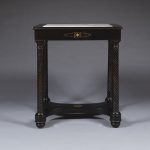
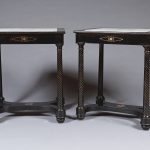

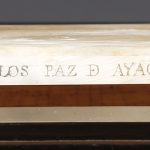
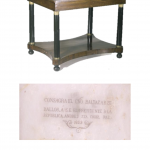
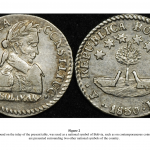
Comments are closed.